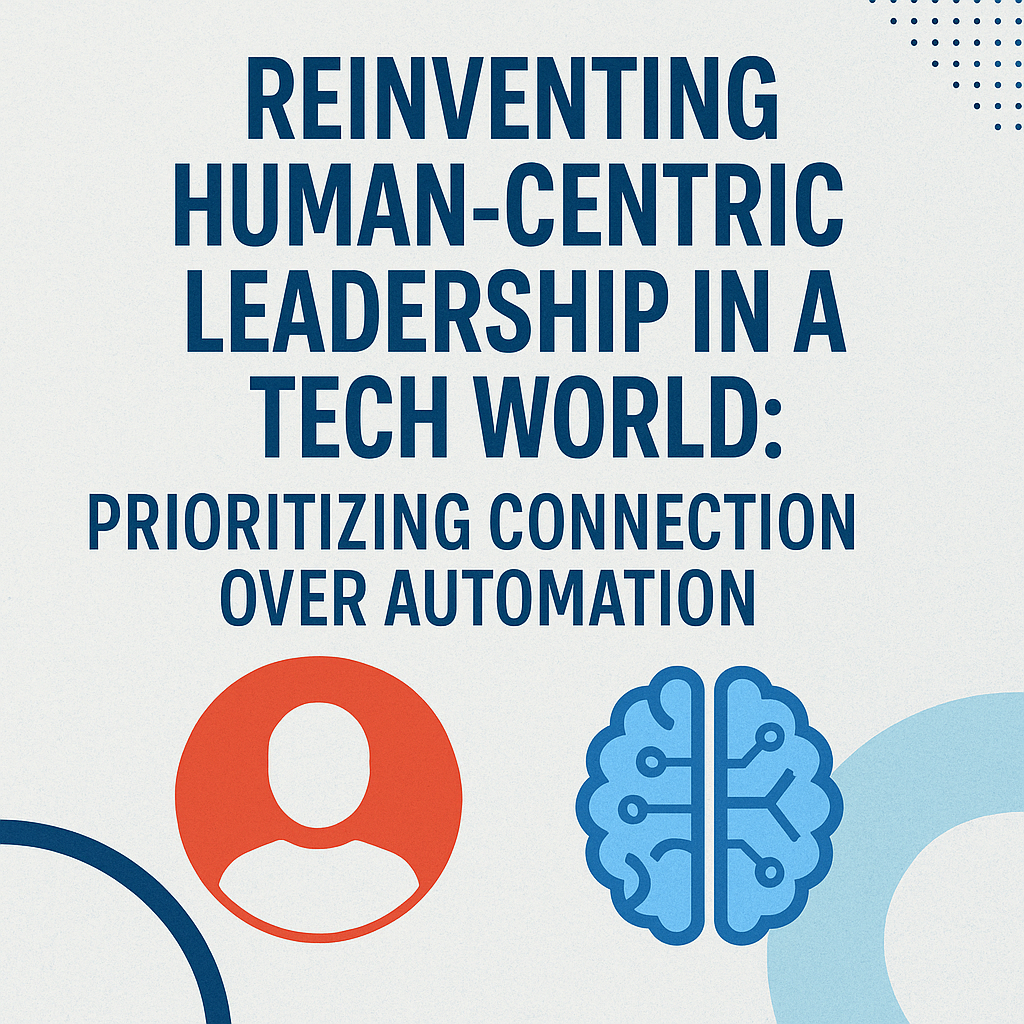Reinventing Human Centric Leadership in a Tech World: Prioritizing Connection Over Automation
How can leaders retain the human touch in a tech-driven world? This article delves into human-centric leadership in a tech world, prioritizing connection over automation. Learn how leaders can balance automation with empathy, ha haemotional intelligence, and genuine human connections to create a thriving workplace.
💡 Want to explore how to lead with empathy and innovation in today’s tech-driven world? Book a free 15-minute call with Joel and take the first step toward more human-centric leadership.
Key Takeaways
- In an AI-driven world, human-centric leadership that emphasizes empathy and emotional intelligence is essential for fostering trust and collaboration.
- Balancing technology and human interaction is key; leaders should leverage AI tools to enhance communication without losing the human touch.
- Prioritizing employee well-being and continuous learning leads to a more engaged workforce, fostering resilience and adapting to the evolving tech landscape.
The Importance of Human-Centric Leadership in the AI Era

In an AI-driven world, the role of leaders is evolving, shaped by rapid technological advancement. Human-centric leadership is becoming indispensable for managing the transition to AI while ensuring it benefits society as a whole. This leadership approach emphasizes empathy, adaptability, and ethical judgment—traits that are essential in an era where technology can easily overshadow the human element. Leaders who focus solely on technology and automation risk neglecting empathy and human values, which are essential for sustainable progress. Prioritizing human well-being over short-term profits fosters a culture of continuous learning and innovation, empowering individuals to thrive in the face of technological advancements and human judgment.
Automation and AI can free individuals from repetitive tasks, enabling them to focus on more complex, human-centric roles that require human input. However, an over-reliance on digital tools risks sidelining the human element, thereby undermining the effectiveness of leadership. There is also the danger of losing sight of human impact and ethical considerations as technology becomes more integrated into organizational practices. While AI can process data efficiently, it lacks the empathy and understanding that humans bring to leadership and decision-making. A balanced integration of automation and machine learning ensures that human connection, creativity, and growth are maintained in the workplace. Despite technological advancements, the irreplaceable human touch remains essential for creating trust, loyalty, and long-term success.
Leaders must cultivate new mindsets, skills, and management approaches to effectively engage teams in the era of AI. This involves rethinking principles to strike a balance between automation and human needs, ensuring that technology serves humanity positively. As we move forward, human-centric leadership will be the cornerstone of sustainable business success, harmonizing technological efficiency with genuine human connection.
🌱 The future belongs to leaders who put people before processes. Ready to lead with heart and vision? Let’s talk.
Embracing Emotional Intelligence in Leadership
Emotional intelligence (EI) is a critical factor for effective leadership, especially in an era dominated by artificial intelligence. Leaders with high EI can coach teams, manage stress, and resolve workplace conflicts effectively. Seventy-one percent of employers consider high emotional intelligence as one of the most desirable qualities in candidates. Self-awareness, a key component of EI, allows leaders to understand their strengths and weaknesses, leading to better decision-making and team management.
Empathy significantly enhances a leader’s effectiveness in decision-making and coaching. Leaders who demonstrate empathy can build deeper connections with their teams, fostering a genuine human connection that technology cannot replicate.
Poor emotional intelligence, on the other hand, can lead to misunderstandings and conflicts in the workplace. Embracing emotional intelligence enables leaders to cultivate a supportive environment that prioritizes employee well-being and fosters human skills and insights.
👂 Emotional intelligence isn’t just a buzzword—it’s your leadership edge. Want to develop yours? Schedule a free strategy call today.
Balancing Technology and Human Interaction

The digital transformation necessitates intentional strategies to maintain and enhance human connections, ensuring that technology does not replace personal interactions. Building authentic relationships in a digital environment requires leaders to foster genuine human connections by taking intentional actions that address both emotional and social needs. Emotional intelligence (EQ) emerges as a key differentiator in an increasingly automated world, enabling leaders to foster deeper connections and bring unique human qualities to the workplace. At the same time, automation and AI algorithms can efficiently handle routine processes, freeing up humans to focus on more meaningful, creative, and strategic work.
Leaders must skillfully use tech tools while knowing when to set them aside for meaningful human interaction. Balancing automation with human-centred approaches is vital for maintaining effective workplace interactions, especially when considering the role of human workers. AI algorithms are increasingly used to automate routine tasks, enabling human employees to focus their efforts on higher-level responsibilities, such as strategy, innovation, and interpersonal skills.
Incorporating emotional intelligence and technology-driven efficiency helps create a harmonious work environment that balances efficiency with the human touch. This balance is essential for fostering a culture where human creativity and growth are prioritized alongside technological advancements.
🤖 + ❤️ = Great Leadership. Learn how to balance automation with authentic connection. Book your 15-minute call now and get started.
Leveraging AI Tools for Enhanced Communication
AI tools can significantly enhance human interaction across industries by streamlining communication and allowing teams to collaborate more effectively. Engaging employees in the implementation of AI tools fosters a sense of teamwork and improves the adoption of these technologies. Open communication channels and feedback about AI tools are essential for their successful integration.
As organizations navigate digital transformation, AI tools offer a competitive edge by enhancing communication efficiency and collaboration. However, leaders must ensure that these tools complement, rather than replace, human interaction, thereby preserving the irreplaceable human element in the workplace.
Real-World Example: AI in Customer Service
AI has revolutionized customer service by providing immediate responses to customer inquiries, enhancing the overall service experience. However, empathy remains a key component of customer service that AI cannot replicate. The human touch in customer interactions ensures that customers feel valued and understood, fostering loyalty and trust.
Generative AI can support customer service representatives by handling routine inquiries, allowing them to focus on more complex and empathetic interactions. This combination of AI efficiency and human empathy creates a balanced approach that enhances the customer experience while maintaining the essential human connection.
Prioritizing Employee Well-Being and Mental Health

Prioritizing employee well-being and mental health is crucial for enhancing productivity and employee retention. Companies that prioritize their employees’ well-being often experience significant improvements in these areas. Neglecting mental health, on the other hand, can lead to decreased productivity and increased turnover rates. Trust-building with employees about the role of AI in the workplace is crucial for successful integration.
Human-centric leaders must create environments that prioritize emotional support and psychological safety. By fostering a supportive workplace culture and implementing programs for continuous learning, teams can remain engaged, motivated, and resilient amidst technological advancements.
💬 Want a culture where people thrive, not just survive? Let’s design a workplace where well-being fuels performance. Let’s connect.
Creating a Supportive Workplace Culture
A psychologically safe workplace promotes employee engagement and reduces conflict. A supportive workplace culture encourages employees to express their thoughts and feelings without fear, thereby enhancing job satisfaction. By applying principles of empathy and cultural sensitivity, organizations can foster a more inclusive workplace, which in turn improves team dynamics and collaboration.
Human-centric leadership involves creating environments where employees feel valued and supported. By prioritizing emotional support and psychological safety, leaders can foster a workplace culture that enhances employee well-being and productivity through human-centred leadership.
Implementing Programs for Continuous Learning
Building a culture of continuous learning is vital for adapting to AI’s evolving landscape. Continuous upskilling has become essential, as the relevance of skills diminishes faster than ever in a changing work environment. Blending technical knowledge with emotional intelligence is a key component of training for leaders in a tech-driven environment.
Organizations are recommended to invest in employee development, with a suggested ratio of $ 1 in AI for every dollar in development. Implementing programs for continuous learning ensures that teams remain adaptable, skilled, and prepared to leverage new technologies effectively.
Ethical Considerations in AI Deployment
A strong ethical framework is essential for leaders using AI to deploy it responsibly and protect against biases. Policymakers play a vital role in ensuring that AI adheres to ethical principles, addressing issues such as bias and transparency. Organizations should implement clear guidelines and conduct regular audits to ensure the ethical use of AI.
Aligning AI adoption with human values can lead to stronger employee loyalty and better decision-making. Leaders must evaluate what AI should do ethically within their organizations, recognizing potential biases and ethical implications. By asking the right ethical questions and cultivating discernment in the application of AI tools, they can ensure the responsible and fair adoption of AI deployment.
🧭 Ethics in tech isn’t optional. It’s a leadership imperative. Curious how to lead with integrity in an AI world? Book a time to talk.
Ensuring Transparency and Accountability
Transparency in AI systems is crucial for maintaining trust and integrity among users and stakeholders. Accountability in AI processes ensures that decisions made by these systems can be traced and justified, reinforcing trust in their outcomes. Implementing ethical AI practices creates a foundation for trust, as stakeholders can be assured that their interests are prioritized and safeguarded.
Establishing clear guidelines and standards for the ethical use of AI can help prevent misuse and bolster confidence among users. Engaging diverse stakeholders in the AI development process can align the technology with societal values and expectations, ensuring that AI systems operate transparently and accountably.
Addressing AI Bias and Fairness
With the growth of AI, leaders must prioritize fairness and mitigate the unintended harms that technology may cause. Addressing AI bias and ensuring fairness are critical for supporting ethical decision-making in organizations. Leaders play a crucial role in ensuring that technologies align with ethical standards and consider the broader economic impact of AI to avoid community struggles.
By implementing strategies to address AI bias and promoting fairness, leaders can create a more equitable and just use of AI technologies. This ethical approach not only supports better decision-making but also aligns AI with human-centred values.
Enhancing Human Creativity with AI

AI should be perceived as a complementary tool that enhances human capabilities rather than as a replacement. By automating repetitive tasks, AI enables individuals to focus on more complex and creative problem-solving activities. Generative AI has the potential to support human creativity by enabling innovative thinking and making the process of creating new content more accessible and efficient.
Generative AI can increase employee creativity, particularly for those who actively reflect on their use of the technology. AI can help democratize innovation by providing tools that enhance creative capabilities across various sectors. Leveraging AI helps foster a culture of creativity and innovation that drives long-term success.
🎨 Tech supports, humans create. Discover how to unlock your team’s creativity in the AI era. Book a call to begin the transformation.
Building Strong Human Connections in a Digital World
To strengthen human connections in a digital world, individuals should prioritize being present and fully engaged in interactions, minimizing distractions during conversations to foster meaningful connections. Amid digital transformation, maintaining strong human connections is crucial for effective collaboration and team dynamics. Human-centric leadership emphasizes the importance of emotional intelligence, human insight, and interpersonal skills in building genuine human connections that technology cannot replace.
Encouraging active listening and empathy helps deepen trust and rapport within teams. Promoting open communication channels ensures that team members can voice concerns and share ideas freely, fostering a culture of innovation and collaboration.

Encouraging Active Listening and Empathy
Active listening goes beyond hearing words; it involves understanding the emotional intent behind what is being said, which helps to deepen trust and rapport. Fully concentrating on the speaker, understanding their message, and responding thoughtfully fosters deeper connections and enhances team relationships.
Active listening and demonstrating empathy help create a supportive environment that prioritizes human well-being. This approach not only enhances communication but also strengthens interpersonal relationships within teams, leading to improved collaboration and productivity.
Promoting Open Communication Channels
Open communication channels enable team members to voice their concerns and share ideas freely, which is crucial for fostering innovation. Creating a safe environment for sharing feedback and ideas ensures that individuals can express their concerns without fear, thereby enhancing collaboration and team dynamics.
Facilitating open communication helps prevent misunderstandings and enhances overall performance. Prioritizing open communication channels ensures all voices are heard, fostering a culture of transparency and trust within the organization.
Preparing Leaders for a Human-Centric Future
Future leaders must be agile, emotionally intelligent, and digitally fluent to navigate the complexities of modern organizations. Human-centric leadership ensures that employees are valued as individuals, not just resources, thereby fostering well-being and loyalty. To thrive in a tech-driven future, leadership training must strike a balance between technical fluency and emotional intelligence, emphasizing qualities such as empathy, inspiration, and integrity.
Continuous learning initiatives enable employees to develop critical skills that enhance their adaptability in a rapidly changing work environment. By fostering a culture of lifelong learning, teams are well-equipped to manage change and leverage new technologies effectively. This holistic approach prepares leaders to maintain a human-centric mindset while embracing technological advancements.
Developing Critical Thinking and Strategic Vision
Leaders must cultivate the ability to think critically and strategically to address the rapidly evolving technological landscape. Strategic thinking and vision are essential for leaders to anticipate and navigate the complexities of emerging technologies. By integrating critical thinking with strategic vision, leaders can enhance their decision-making processes, ensuring they are well-prepared to navigate future challenges.
Developing critical thinking and strategic vision is essential for preparing leaders to thrive in a tech-driven future. This requires a deep understanding of data analysis, creative problem-solving, and financial forecasting, balanced with a focus on ethical decision-making and human-centric leadership. By honing these skills, leaders can maintain a competitive edge while prioritizing human values and well-being.
Fostering Lifelong Learning and Adaptability
Adaptability is the most crucial leadership skill for the future, underscoring the need for leaders to navigate constant change. As technology continues to evolve, leaders must be adaptable to guide their teams effectively through the complexities of modern challenges. Lifelong learning plays a vital role in developing adaptability, encouraging leaders to continually update their knowledge and skills.
To remain relevant in a rapidly changing landscape, business leaders must prioritize cultivating adaptability in themselves and their teams. By fostering a culture of lifelong learning and embracing continuous learning initiatives, leaders can ensure long-term success and resilience in the face of technological advancements, gaining a competitive advantage and experiencing a rapid rise.
This approach not only enhances technical proficiency but also strengthens human-centric leadership, ensuring that human needs and well-being remain at the forefront through a human-centric approach to human resources. At the same time, we prioritize human well-being and uniquely human skills.
Summary
In conclusion, reinventing human-centric leadership in a tech world requires a delicate balance between leveraging AI for efficiency and maintaining genuine human connections. By embracing emotional intelligence, prioritizing employee well-being, and fostering a culture of continuous learning, leaders can navigate the complexities of the AI era. Ethical considerations, transparency, and accountability in the deployment of AI are crucial for ensuring the fair and responsible use of technology. Ultimately, the goal is to enhance human creativity, build strong connections, and prepare leaders for a future where human values and well-being are prioritized. Let us embrace this journey towards a more human-centric approach to leadership, where technology serves to amplify our uniquely human skills and insights.
🚀 You don’t have to navigate this alone. If you’re ready to lead with empathy, clarity, and purpose in a tech-driven world, book your complimentary 15-minute coaching call with Joel today.
Frequently Asked Questions
Why is human-centric leadership important in the AI era?
Human-centric leadership is crucial in the AI era, ensuring that technology serves society’s needs while preserving the human touch that fosters trust and loyalty. By focusing on people, we can strike a balance between innovation and empathy, leading to sustainable success.
How does emotional intelligence contribute to effective leadership?
Emotional intelligence is crucial for effective leadership, as it enables leaders to manage stress, resolve conflicts, and build strong connections with their teams. This not only fosters a positive work environment but also enhances decision-making and overall team performance.
What are some strategies for balancing technology and human interaction?
To strike a balance between technology and human interaction, utilize AI tools to enhance communication, but don’t hesitate to set technology aside for more meaningful, face-to-face connections. Remember, genuine human interactions and emotional intelligence are essential for fostering stronger relationships.
Why is it important to address ethical considerations in AI deployment?
It’s crucial to address ethical considerations in AI deployment to ensure that technology is used responsibly and fairly. By focusing on ethics, we can establish a framework that promotes transparency, accountability, and reduces bias, thereby aligning AI with our values and societal needs.
How can leaders foster lifelong learning and adaptability in their teams?
To encourage lifelong learning and adaptability within your team, focus on implementing continuous learning programs and actively promoting a culture that fosters change. This way, your team will stay resilient and ready to tackle new challenges head-on.



